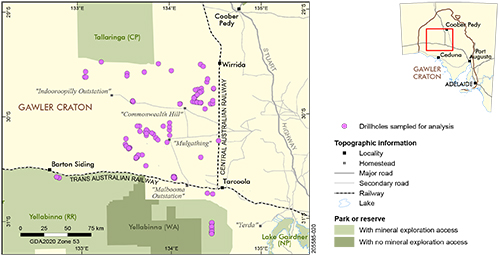Part of the planned data acquisition for the central-western Gawler Craton.
One of the first major acquisition projects of the Gawler Phase 2 (GP2): next generation mineral systems mapping project has seen over 300 whole-rock geochemical samples submitted for analysis to Bureau Veritas (Fig 1). Results were finalised in early 2022 and will be available early March via the South Australian Resource Information Gateway (SARIG).
Figure 1 Drillholes sampled for whole-rock geochemical analysis, GP2 project.
Combining machine learning (ML), artificial intelligence (AI) and data science with geoscientific knowledge and data has been a theme in South Australia in recent years, spurred on by the successful Explore SA: the Gawler Challenge, a partnership between the South Australian Government and Unearthed. On the back of this innovation challenge, GP2 was launched in 2021 to deliver on the promise that data science brings to mineral exploration.
A key goal of GP2 is to develop improved ways to deliver data for consumption by ML, AI and data science processes. The project has a focus on growing the connection between the geoscience and ML communities, as well as an opportunity to generate new geoscience datasets corresponding to learnings and outputs from the Gawler Challenge.
The new data acquisition programs are being driven by the Geological Survey of South Australia (GSSA). The goal is to significantly increase the number of precompetitive geoscience data layers, based on ML and AI outputs that build on ExploreSA: The Gawler Challenge. As a result, inferences can then be made using data science and the mineral potential of a largely underexplored part of the state can be assessed for Ni–Cu, platinum group elements and Au mineralisation, in particular.
The new geochemical data is the foundation of the push to better understand the geology and mineral potential of the target region. Over 100 drill cores in storage at the South Australia Drill Core Reference Library were inspected and sampled by the GSSA in late 2021, many of which have had very little prior geochemical characterisation. The geochemical data will be coupled with new geochronological studies on the drill cores, which will be undertaken in partnership with Curtin University and the University of Adelaide.
The new data will also provide a crucial constraint for the planned geophysical surveys which are anticipated to incorporate around 5,800 gravity and 380 magnetotelluric sites.
In parallel, we are placing significant effort to capture legacy data within the project. Currently, GSSA is working to collate legacy exploration data from the target regions of the Gawler Craton, with a focus on lithology logs for drillholes, as well as digitising previously unavailable geochemical data.
– Anthony Reid and Stephan Thiel, March 2022



